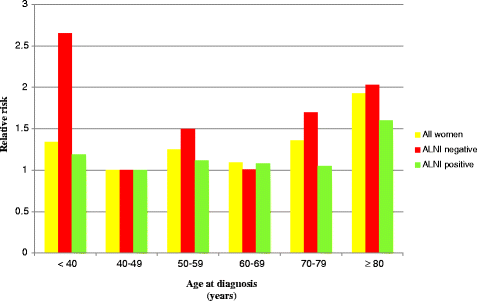Age at diagnosis in relation to survival following breast cancer: a cohort study
- PMID: 25889186
- PMCID: PMC4344734
- DOI: 10.1186/s12957-014-0429-x
Age at diagnosis in relation to survival following breast cancer: a cohort study
Abstract
Background: Age is an important risk factor for breast cancer, but previous data has been contradictory on whether patient age at diagnosis is also related to breast cancer survival. The present study evaluates age at diagnosis as a prognostic factor for breast cancer on a large cohort of patients at a single institution.
Methods: All 4,453 women diagnosed with breast cancer in Malmö University Hospital, Sweden between 1961 and 1991 were followed up on for 10 years with regards to breast cancer-specific mortality (BCSM) in different age groups. Corresponding relative risks (RR), with 95% confidence intervals, were obtained using Cox's proportional hazards analysis. All analyses were adjusted for potential confounders and stratified for axillary lymph node involvement (ALNI) and diagnostic period.
Results: As compared to women aged 40 to 49 years, those who were aged under 40 (RR: 1.40; 95% CI: 1.04 to 1.88) and 80 or more years (RR: 1.80; 95% CI: 1.45 to 2.25) had a statistically significant higher 10-year mortality rate. When adjusted for potential confounders, including stage at diagnosis, the associations only remained statistically significant for women aged 80 years or more. In the analyses stratified on ALNI, ALNI-negative women under 40 years had a statistically significant higher five-year mortality rate (RR: 2.65; 95% CI: 1.23 to 5.70). In the analyses stratified on diagnostic period, the positive association between women aged under 40 or aged 80 or more years and high BCSM rate remained, with statistically significant results for women aged 80 years or more in all periods.
Conclusions: Women under 40 years of age had a poor prognosis, and this association was strongest among young women with axillary lymph node negative breast cancer. An age of 80 years or more was a prognostic factor for poor survival, independent of stage at diagnosis and diagnostic period.
Figures


References
-
- Cancer Incidence in Sweden 2008. National Board of Health and Welfare. 2009. http://www.socialstyrelsen.se/publikationer2009/2009-12-1. Accessed 21 Jan 2015.
-
- Yankaskas BC. Epidemiology of breast cancer in young women. Breast Dis. 2005;23:3–8. - PubMed
-
- Barchielli A, Balzi D. Age at diagnosis, extent of disease and breast cancer survival: a population-based study in Florence, Italy. Tumori. 2000;86(2):119–23. - PubMed
Publication types
MeSH terms
LinkOut - more resources
Full Text Sources
Other Literature Sources
Medical
Research Materials

